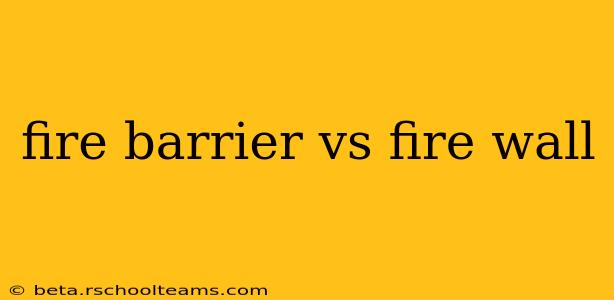The terms "fire barrier" and "firewall" are often used interchangeably, leading to confusion. However, these two terms represent distinct components within fire protection systems, each serving a crucial yet different purpose. This comprehensive guide will clarify the distinctions between fire barriers and firewalls, helping you understand their roles in ensuring building safety.
What is a Fire Barrier?
A fire barrier is a continuous, fire-resistant assembly designed to restrict the spread of fire and smoke within a building. It's a passive fire protection system, meaning it doesn't actively fight the fire but rather contains it, preventing its uncontrolled spread. Think of it as a physical blockage that buys valuable time for evacuation and fire suppression efforts. Fire barriers are typically constructed from materials with high fire resistance ratings, such as concrete, masonry, fire-rated drywall, and specialized fire-resistant sealants.
Key Characteristics of Fire Barriers:
- Containment: Their primary function is to contain a fire within a specific area, limiting its spread to other parts of the building.
- Passive Protection: They do not actively extinguish fires but provide structural integrity and fire resistance.
- Construction: They can be constructed from various materials, each rated for a specific level of fire resistance.
- Application: Used in various building structures, including walls, floors, and shafts, to segment the building into fire-rated compartments.
What is a Firewall?
A firewall, in the context of building construction, is a fire-resistant wall that separates two adjacent buildings or different sections of a building. It's designed to prevent the spread of fire from one structure or area to another. Essentially, it acts as an independent fire-resistant barrier between distinct areas.
Key Characteristics of Firewalls:
- Separation: Primarily used to separate buildings or sections of a building to prevent fire spread between them.
- Independent Structure: Often constructed as a freestanding structure with no openings or penetrations that compromise its fire resistance.
- High Fire Resistance: They must have a very high fire resistance rating to withstand intense heat and flames for an extended period.
- Application: Commonly found in multi-building complexes, large industrial facilities, or where distinct fire zones need to be created.
Fire Barrier vs. Firewall: A Side-by-Side Comparison
| Feature | Fire Barrier | Firewall |
|---|---|---|
| Primary Purpose | Restrict fire spread within a building | Prevent fire spread between buildings/sections |
| Location | Within a single building | Between buildings or building sections |
| Construction | Various fire-resistant materials | Typically highly fire-resistant materials |
| Size | Varies depending on application | Typically larger and more substantial |
| Purpose | Compartmentalization | Complete separation |
How are Fire Barriers and Firewalls Rated?
Both fire barriers and firewalls are assigned fire resistance ratings, usually expressed in hours. This rating indicates how long the structure can withstand a standard fire test without failure. For example, a 2-hour rated barrier means it can resist a standardized fire for two hours. These ratings are crucial for determining the level of fire protection provided by each element.
What are some common questions about fire barriers and firewalls?
What is the difference between a fire barrier and a fire wall in construction?
The key difference lies in their location and purpose. Fire barriers contain fire within a building, while firewalls separate fire between buildings or building sections. Firewalls provide a higher level of protection due to their independent construction and higher fire resistance ratings.
Are fire barriers and firewalls the same thing?
No, they are not the same thing. While both are fire-resistant structures, they serve different purposes and have different design considerations. A fire barrier is internal, while a firewall is external or between distinct building sections.
What materials are used to create fire barriers and firewalls?
Both utilize fire-resistant materials, including concrete, masonry, fire-rated drywall, and specialized sealants. However, the specific materials and their thickness will vary depending on the required fire resistance rating.
This detailed explanation provides a clear understanding of the critical differences between fire barriers and firewalls, their applications, and the standards governing their construction and ratings. Remember, consulting with qualified fire protection engineers and adhering to local building codes are vital for ensuring the safety and compliance of any construction project.
